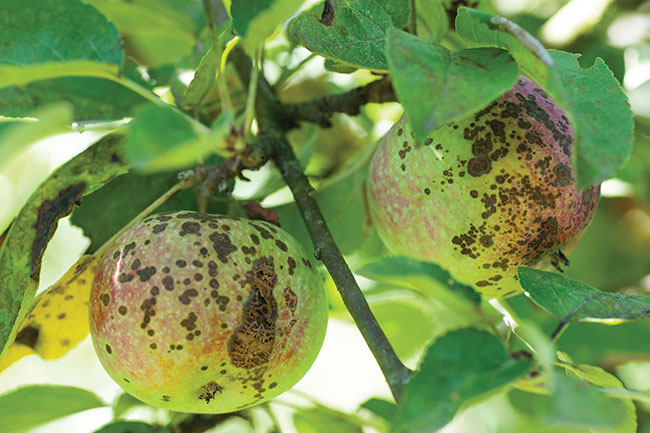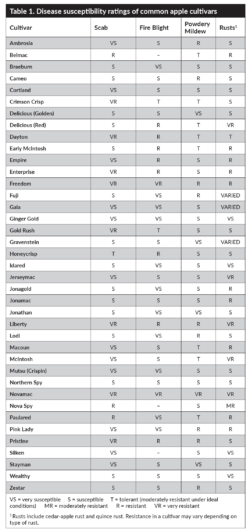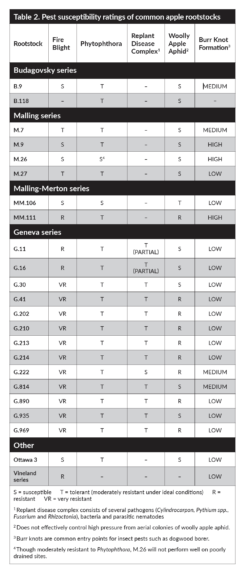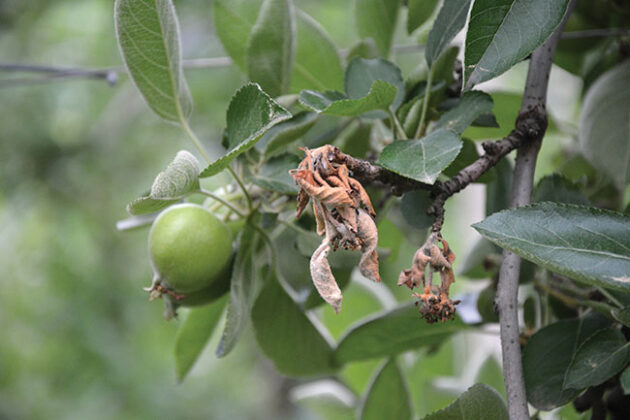
Features
Diseases
Planting
Pest susceptibility of common apple cultivars and rootstocks
Get a leg up on pest management planning if you’re considering replanting apple orchards.
April 9, 2024 By Kristy Grigg-McGuffin, OMAFRA apple IPM specialist
 Apple scab is a serious fungal infection, damaging the foliage, blossoms, and fruit. Infected fruit are unmarketable.
Photo © _Vilor / iStock / Getty Images Plus
Apple scab is a serious fungal infection, damaging the foliage, blossoms, and fruit. Infected fruit are unmarketable.
Photo © _Vilor / iStock / Getty Images Plus Pest susceptibility varies among apple cultivars and rootstocks. Understanding, selecting and managing for particular characteristics is an important component to a successful integrated pest management (IPM) program. This information can be used when buying new trees, selecting appropriate planting sites or developing a block design, considering a pest control program including resistance management strategies, as well as for scouting or monitoring. With the recent announcement of the Growing Future Opportunities Initiative, a cost-share program to assist growers in replanting, there will be many considering which rootstock and cultivar options are best for their farm.
 Table 1 summarizes some of the more common apple cultivars grown in Ontario. It is by no means an extensive list. While some cultivars have resistance to a number of the major diseases Ontario growers deal with, those growers who sell to retailers will be largely influenced by market acceptability. For example, organic growers or those who have on-farm markets can have a consumer base for scab-resistant cultivars such as Enterprise, Freedom, Liberty, Prima or Pristine, whereas large-scale retailers would not.
Table 1 summarizes some of the more common apple cultivars grown in Ontario. It is by no means an extensive list. While some cultivars have resistance to a number of the major diseases Ontario growers deal with, those growers who sell to retailers will be largely influenced by market acceptability. For example, organic growers or those who have on-farm markets can have a consumer base for scab-resistant cultivars such as Enterprise, Freedom, Liberty, Prima or Pristine, whereas large-scale retailers would not.
As with every management strategy in an IPM program, use of resistant cultivars is not a stand-alone control. Under high disease pressure, even resistant cultivars can show symptoms. However, incorporating cultural (e.g., orchard sanitation, urea, removal of wild hosts), physical (e.g., pruning) and chemical (e.g., organic, biological or conventional pesticides) controls in disease-resistant plantings will help reduce overall inoculum pressure from these pathogens long-term.
Continue to also monitor and manage other diseases common in Ontario orchards, such as fruit rots, sooty blotch and fly speck. These pests may become an issue if fungicides that normally control them are reduced (e.g., after primary scab infection period or late summer). While there are cultivars that are known to be more susceptible to these diseases, there are no resistant cultivars available.
 Table 2 summarizes pest susceptibility characteristics of some apple rootstocks. Similar to Table 1, this list is not extensive nor does it represent what rootstocks are currently available in your area. Speak with your nursery to determine your options. For fire blight and, to an extent, woolly apple aphid, rootstock resistance can be conferred to the scion. Again, similar to what was mentioned earlier, this would be under ideal conditions only. If pest pressure is high, relying on rootstock resistance alone will not provide effective control, especially if the cultivar is susceptible to the pest.
Table 2 summarizes pest susceptibility characteristics of some apple rootstocks. Similar to Table 1, this list is not extensive nor does it represent what rootstocks are currently available in your area. Speak with your nursery to determine your options. For fire blight and, to an extent, woolly apple aphid, rootstock resistance can be conferred to the scion. Again, similar to what was mentioned earlier, this would be under ideal conditions only. If pest pressure is high, relying on rootstock resistance alone will not provide effective control, especially if the cultivar is susceptible to the pest.
Replant disease complex consists of several pathogens (Cylindrocarpon, Pythium spp., Fusarium, and Rhizoctonia), bacteria and parasitic nematodes as well as abiotics factors such as soil pH, moisture stress, soil compaction, toxins, soil structure and nutrient availability. Rootstocks are considered tolerant to replant disease when they show a level of resistance to one or more pathogens. This doesn’t account for all factors that come into play with the replant disease complex and may not improve tree vigour depending on the planting site.

Fire blight is a destructive bacterial disease that causes severe blighting of blossoms, shoots, tree limbs and fruit.
Photo © Matthias Matscher / iStock / Getty Images Plus
The ability of a rootstock to tolerate insect pressure can be considered with woolly apple aphid and borers that prefer burr knots, such as dogwood borer. In sites that have a history of pest pressure, rootstock selection may be beneficial. However, it is important to note there are root and aerial populations of woolly apple aphid. If control is limited with the aerial population, tree vigour will still be reduced, particularly on young trees. As well, dogwood borer infests a tree at a weakened site which also includes near cankers, pruning cuts, mechanical damage or winter injury. Management of the population will still be important even if burr knots are minimal.
Print this page